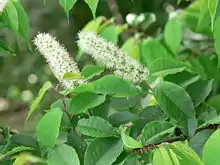Prunus grayana
Prunus grayana (syn. Padus grayana (Maxim.) C.K.Schneid., Prunus padus var. japonica Miq.; Japanese bird cherry or Gray's bird cherry; Japanese ウワミズザクラ Uwa-mizu-zakura; Chinese 灰叶稠李 hui ye chou li) is a species of cherry native to Japan and China, occurring at medium altitudes of 1,000–3,800 m in the temperate zone. It prefers sunshine and moist (but drained) soil.[3][4][5]
| Prunus grayana | |
|---|---|
 | |
| Scientific classification | |
| Kingdom: | |
| (unranked): | |
| (unranked): | |
| (unranked): | |
| Order: | |
| Family: | |
| Genus: | |
| Subgenus: | |
| Species: | P. grayana |
| Binomial name | |
| Prunus grayana | |
| Synonyms[2] | |
| |
It is a small deciduous tree reaching a height of 8–20 m. The trunk is slender with smooth grey to purple-grey bark marked with horizontal brown lenticels, with a strong smell when cut. The leaves are elliptical to ovoid, 4–10 cm long and 1.8–4.5 cm broad, with a serrated margin with aristate tips to the serrations. The lowest teeth of a leaf feature two glands. The flowers are produced on 5–8 cm long racemes, each flower 7–10 mm diameter, with five white petals; they are hermaphroditic, and appear in mid-spring after the leaves. The fruit is a small drupe, about 8 mm in diameter, green at first, then red and finally ripening black in mid summer.[3][4][6][7][8]
It is very closely related to Prunus padus (Bird cherry), differing in the aristate tips to the leaf serration (blunt-pointed in P. padus), and the longer style in the flower.[7][9]
Uses
The flowers, fruit and seed are all edible and are prepared and eaten in Japan. The fruit can be preserved with salt to make a dish called Anningo. The bark and roots are the source of a green dye. The wood is very hard and splits easily. It is used in various cabinet-making and various other ornamental applications.[4][10]
Classification
The taxon was described in 1864 by Miquel as Prunus padus var. japonica, on the basis of specimens collected by Siebold.[11] After a review of the previous literature, Maximowicz in St. Petersburg decided in 1883[12] the tree was a distinct species, and named it Prunus grayana after Asa Gray.
References
- Rehder, A. 1940, reprinted 1977. Manual of cultivated trees and shrubs hardy in North America exclusive of the subtropical and warmer temperate regions. Macmillan publishing Co., Inc, New York.
- "The Plant List: A Working List of All Plant Species". Retrieved January 27, 2014.
- Flora of China: Padus grayana
- Japanese Tree Encyclopedia: Uwamizuzakura Prunus grayana
- "Prunus grayana". Germplasm Resources Information Network (GRIN). Agricultural Research Service (ARS), United States Department of Agriculture (USDA). Retrieved 21 January 2018.
- Botanic Japan: Prunus grayana (in Japanese; google translation.
- Huxley, A., ed. (1992). New RHS Dictionary of Gardening. Macmillan ISBN 0-333-47494-5.
- https://pfaf.org/user/Plant.aspx?LatinName=Prunus+grayana
- Flora of China: Padus
- Plants for a Future: Prunus grayana
- Ohba, H., Akiyama, S., & Thijsse, G. (2003). Miquel's new taxa of the vascular plants described from Japan in Prolusio Florae Japonicae and some other works. Page 3
- Maximovicz, J.C. (1883). "Diagnoses plantarum asiaticarum". Bulletin de l'Académie Impériale des Sciences. XXIX (27): 51–228. For the details of the publication including the dates of the volumes and the reprint of the article in Mélange ... see Pagès, Léon; Wenckstern, Friedrich von; Palmgren, Valfrid (1895). A Bibliography of the Japanese Empire. Leiden: E. J. Brill. p. 223.
External links
| Wikimedia Commons has media related to Prunus grayana. |
| Wikispecies has information related to Prunus grayana. |